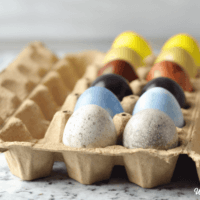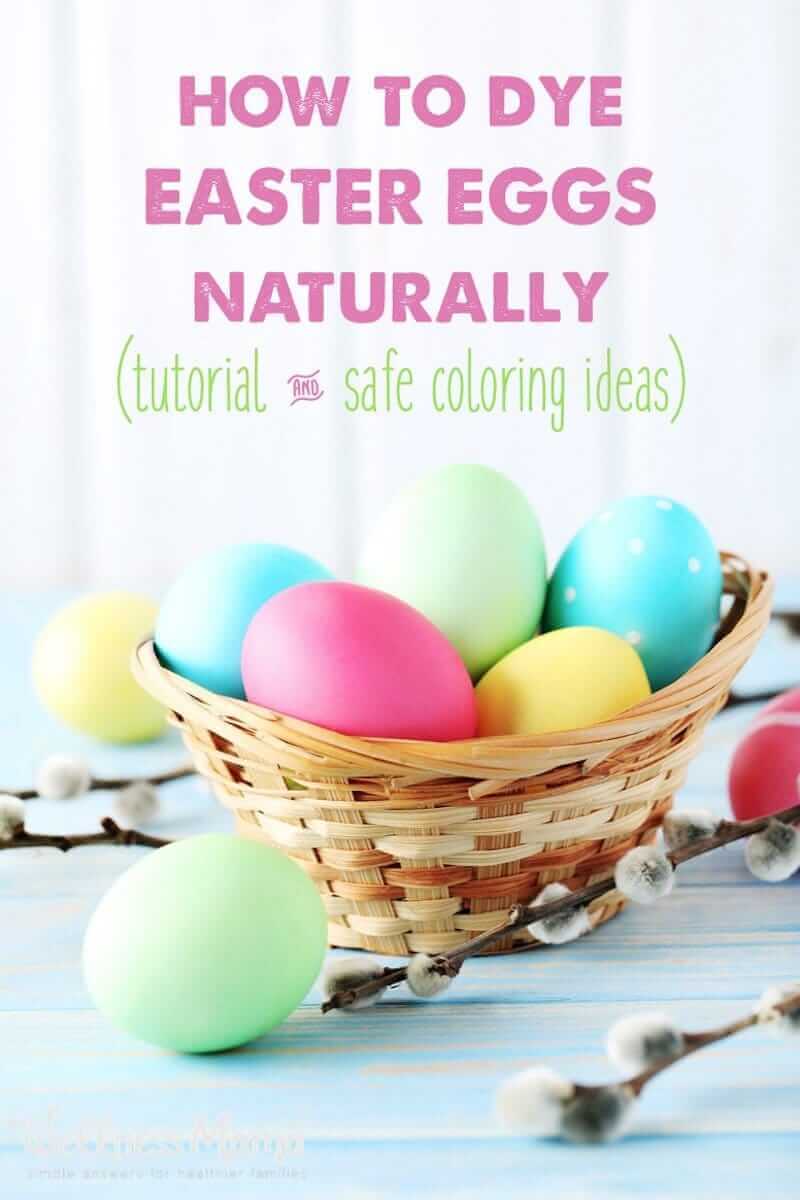There are few things I love more than a basket full of colorful Easter eggs. Easter is important in our family and one of our favorite times of the year. However, I often find myself annoyed with the over-commercialization. I also get peeved when Easter gets turned into an excuse to let kids (and ourselves) over-indulge in treats filled with sugars, food dyes, and artificial ingredients.
I’m glad to let the kids enjoy some treats for a special occasion. I’m opting, though, to keep some of our favorite traditions with healthy and natural twists.
Let me explain why!
“Naturally Dyed Easter Eggs… Too Extreme?
I’ll admit I don’t really understand the Easter tradition of a bunny (they don’t lay eggs) delivering plastic candy-filled eggs and baskets. I think giving our kids heaps of junk food at Easter (and other holidays) sets a precedent that associates celebrations with unhealthy foods. To me, there are better ways to develop good food habits for a lifetime.
This may sound extreme to some. Certainly, there’s nothing wrong with an occasional indulgence in a food that’s less than healthy. But I think most concerned parents would agree that kids these days are getting these indulgences a little too often. From the birthdays of every kid in their class at school to Valentine’s Day, Halloween, Easter, etc., there are more than enough opportunities for kids to get the message that fun and celebration = unhealthy tasty sweet foods.
(Perhaps that’s just a pet peeve of mine, though?!)
But let me get off my soapbox… on to Easter eggs!
How to Dye Easter Eggs Without Synthetic Colors
Eggs are one of our favorite foods, so I certainly don’t have any problems with the eggs themselves. As you may guess, it’s the plastic, candy-filled versions I take issue with.)
It turns out that the harmless-looking color tablets used to dye Easter eggs contain harmful dyes that can have a bad effect on some kids. Even just this year the FDA banned certain red food dyes, yet synthetic colors are still allowed in food. True, we don’t eat the shells, but eggshells are permeable. Some kids are so sensitive to the effects of artificial food dyes, that I thought it was worth exploring more natural dyes.
There are several ways to use natural ingredients for coloring eggs. There are even dye kits made with natural colors from food now that come in different shades!
Option 1: Store-bought Natural Egg Dye
To dye Easter eggs naturally the easy way, use a safe, natural food coloring. Mix according to the following ratios and soak your eggs in the dye bath until they’re the desired color. Or buy premade natural dye tablets here and follow the package instructions.
Option 2: Natural Egg Dye from Fruits and Veggies
If you don’t have natural food coloring around (we often don’t), you can also use fruits, veggies, and herbs to accomplish the same thing. We tried this a few years ago and will be doing it again this year.
Below are the foods that can be added to boiling water while cooking eggs to make various colors. You can also juice or boil the ingredients, cool to room temperature, add vinegar, and use it as natural Easter egg dye.
- Blue Coloring: Add a cup of purple cabbage to the water when boiling the eggs.
- Purple – Add a cup of blueberries to the water. This can make a very deep, purple hue!
- Brown Coloring – Onion skins make a nice, golden brown color. Spinach leaves create a yellowish brown.
- Green Coloring: Add a Tablespoon of spirulina to the boiling water. You can also juice greens, mix the juice with vinegar, and use it as a cool dye once the eggs are cooked.
- Red/Pink Coloring: Pomegranate or beet juice is added to the boiling water. You can also put a couple of tablespoons of vinegar in pomegranate or beet juice and use it on pre-cooked eggs as a cool dye.
- Purple Coloring: Add grape juice to boiling water or soak pre-cooked eggs in grape juice/vinegar mix. This makes for a speckled purple egg.
- Yellow/Orange Coloring: Add a few teaspoons of turmeric or saffron to the boiling water, or boil these spices in water, cool, and mix with vinegar for a cool dye.
Some notes: These natural variations make pastel-colored eggs which I think are more beautiful than the neon eggs created with artificial colors. Just a warning, though, you won’t be getting any florescent shades with these methods!

DIY Natural Egg Dye Tutorial
These beautifully colored Easter eggs feature natural hues. A fun project to do with the kids!
For each color you’ll need 1-2 cups of plant material for every 2 cups of water. Use 2 cups for a more vibrant color. Since the turmeric is a dried powder you’ll only need 1/4 cup of this to make yellow turmeric dye.
Add 1-2 cups of one fruit or veggie of choice to the pot along with 2 cups of water and bring to a boil. Reduce heat and simmer for 20-30 minutes with the lid on. You can add the raw eggs and vinegar to the water and fruit/veg as it simmers, but reduce the simmer time to 15 minutes or they’ll be hard and overcooked.
Allow the liquid to cool to room temperature, then strain out the fruit/veg and compost. Squeeze the plants to extract as much color as possible. If you’re boiling the eggs with the dye liquid, then simply remove the eggs from the liquid once it’s cooled and they’re done.
Place undyed, hardboiled eggs into the natural dye liquid and add 2 TBSP vinegar. Let them soak for several hours or overnight in the fridge.
For a stronger dye effect, dry the eggs off after a few hours with a paper towel or fabric towel/clean old shirt you don’t mind getting stains on, then put them back in the dye for several more hours.
Remove the eggs from the liquid once they’re dyed and pat dry. Rub the shell with a little oil to make them shiny if desired.
- You can dye brown eggs, but the colors will be slightly different and a little more muted than white eggs.
- Making the dye first, then soaking hardboiled eggs in the water makes the colors more vibrant than boiling the eggs in the water.
- Before dying you can use a white crayon to make designs on the egg. The patterns will show up once it’s dyed!
Strategies for Easter Egg Hunts
I’ve never been a huge fan of Easter egg hunts and would forgo them completely, but the kids really look forward to them. Unfortunately, they usually result in a large bag of candy that somehow disappears when my kids are sleeping (maybe the Easter Bunny stole it!)
In the past, I’ve also hidden hard-boiled eggs for them to find (the dogs found the ones they missed!). Or we just have a family day outside that involves a lot of other activities. Last year, we did a treasure hunt with clues that led to a better prize (seeds for them to plant in their own little corners of the garden).
Healthy Candy-free Easter Basket Ideas
I don’t have any problem with Easter being a time of joyful celebration and small gifts. As I mentioned before (probably too much!), it’s the plastic, candy-filled parts of this celebration I take issue with. That being said, I love baskets and store everything in them, so my kids get a (reusable) basket each year filled with (non-sugary) goodies.
Here are some ideas we’ve tried over the years that have been a hit!
Grow Your Own Grass
Grow grass with wheat, alfalfa, or clover seeds in a small dish that will fit in the bottom of your basket. Use this instead of the plastic Easter grass that you find under the couch in September. Kids love the novelty of growing grass indoors. As a bonus, grass is supposed to be great at cleaning indoor air. You can even plant it outside with the kids after Easter. If you aren’t up for growing your own grass, shred paper in a shredder and use it instead. Recyclable when done!
Instead of a Basket, Give Your Child a Flower Pot
In the pot, put a small pair of gloves, a pack of heirloom seeds, and a small shovel, and let your child grow their own container garden. There are even pre-made totes for this. Herbs are one easy option, and kids can use them in the kitchen! This is guaranteed to provide fun longer than plastic toys and pixie sticks.
Check Out Thrift Stores
We’re on a budget, and doing Easter baskets for each kid sure adds up! Check out local thrift stores for some fun gifts for Easter baskets. For instance, for one year, each of the kids got a movie, a book, and some shoes, and I spent less than $10 in total.
Adopt a Family Pet
If you’re brave, consider a small pet. This reinforces the “new life” focus of Easter and will be a lot more exciting than candy and toys. Just be humane! Only adopt a pet if you plan to keep it and care for it, as many baby chickens, ducks, and rabbits are abandoned after Easter.
Give Healthy Foods Instead of Junk
If your kids are looking forward to edible treats, substitute some treats with ones that are healthy and fun. Consider beef jerky, fruit, nuts, or homemade energy bars. Really brave? Make some homemade “peeps” with my probiotic marshmallow recipe.
Check out this post for some other Easter basket ideas! Happy Easter!
What are your favorite ways to dye your Easter eggs? When it comes to candy, do you stick with healthy versions of the usual treats or just let the kids enjoy the unhealthy versions for a day? I’d love to hear your tips and tricks below!
